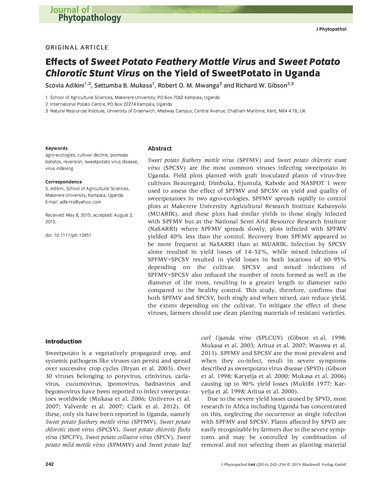Sweet potato feathery mottle virus (SPFMV) and Sweet potato chlorotic stunt virus (SPCSV) are the most common viruses infecting sweetpotato in Uganda. Field plots planted with graft inoculated plants of virus‐free cultivars Beauregard, Dimbuka, Ejumula, Kabode and NASPOT 1 were used to assess the effect of SPFMV and SPCSV on yield and quality of sweetpotatoes in two agro‐ecologies. SPFMV spreads rapidly to control plots at Makerere University Agricultural Research Institute Kabanyolo (MUARIK), and these plots had similar yields to those singly infected with SPFMV but at the National Semi Arid Resource Research Institute (NaSARRI) where SPFMV spreads slowly, plots infected with SPFMV yielded 40% less than the control. Recovery from SPFMV appeared to be more frequent at NaSARRI than at MUARIK. Infection by SPCSV alone resulted in yield losses of 14–52%, while mixed infections of SPFMV+SPCSV resulted in yield losses in both locations of 60–95% depending on the cultivar. SPCSV and mixed infections of SPFMV+SPCSV also reduced the number of roots formed as well as the diameter of the roots, resulting in a greater length to diameter ratio compared to the healthy control. This study, therefore, confirms that both SPFMV and SPCSV, both singly and when mixed, can reduce yield, the extent depending on the cultivar. To mitigate the effect of these viruses, farmers should use clean planting materials of resistant varieties.
Effects of sweet potato feathery mottle virus and sweet potato chlorotic stunt virus on the yield of sweet potato in Uganda
Citation: Adikini, S.; Mukasa, S.B.; Mwanga, R.O.M.; Gibson, R.W. 2016. Effects of sweet potato feathery mottle virus and sweet potato chlorotic stunt virus on the yield of sweet potato in Uganda. Journal of Phytopathology. (Germany). ISSN 0931-1785. 164(4):242-254
2016-03-09
SWEETPOTATO AGRI-FOOD SYSTEMS, SWEETPOTATOES
Eastern Africa
UGANDA
journal_article

